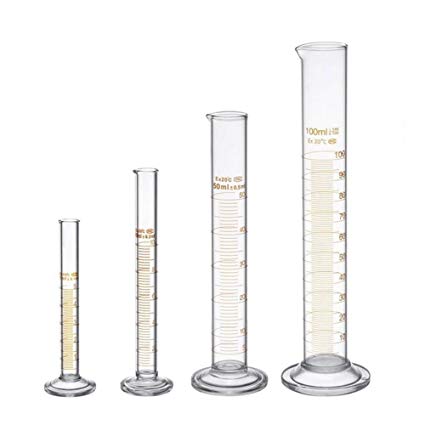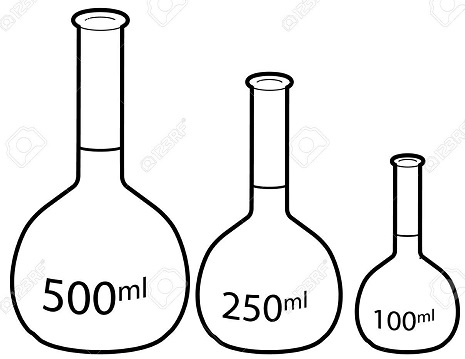1. Measuring cylinder
A measuring cylinder is a cylindrical glass or plastic tube with a base and graduations along its length. It is commonly used for approximate measurements of volume of liquid/ solutions. They are calibrated/graduated to measure any volume required to the maximum. The graduated scale allows you to read the volume at the meniscus, which is the curve formed at the surface of the liquid. Measuring cylinders come in various sizes and capacities, ranging from a few milliliters to several liters for the industrial applications. While they are useful for general measurements, their accuracy is lower compared to other specialized volumetric instruments. An example is the 50ml-measuring cylinder can hold maximum calibrated/graduated volume of 50 mililitres or 50 cubic centimetres

2. Burette
A burette is a long, slender glass tube with a stopcock/tap at the bottom and a precise graduated scale along its length. Burettes are used for accurate and precise titrations, where you need to measure the exact volume of a solution delivered into another. The stopcock/tap at the bottom allows controlled dispensing of the liquid, drop by drop, and the graduations enable you to read the volume with high accuracy. Burettes typically come in 25 ml, 50 ml, or 100 ml sizes

3. Pipette and pipette filler
A pipette is a narrow glass or plastic tube designed to measure and transfer specific volumes of liquids. There are two main types: the volumetric pipette and the graduated pipette.a. Volumetric Pipette
A volumetric pipette is designed to deliver a single, specific volume accurately. It has a tapered tip and a volumetric mark near the top. When you draw the liquid to the mark and then dispense it, the remaining liquid adheres to the walls, ensuring accurate transfer.b. Graduated Pipette
A graduated pipette has graduations along its length and can deliver variable volumes, similar to a measuring cylinder. It requires careful reading of the meniscus to achieve accurate measurements.A pipette filler is a rubber or silicone bulb attached to the top of the pipette. It is used to suck in a liquid solution into a pipette instead of using the mouth. It helps ensure both safety and accuracy.

4. Volumetric flask
A volumetric flask is a pear-shaped glass container with a long neck and a precise single-volume graduation mark. They are thin /narrow at the top but widens at the base/bottom. The maximum calibration / graduation mark is a visible ring, and are named according to their calibrated volume. Further, they are used to prepare a specific volume of a solution accurately. They come in various sizes, from small volumes like 25 ml to larger ones like 1000 ml.Volumetric flasks are designed to hold one fixed volume with high accuracy. To prepare a solution, you measure the exact volume, typically by using a pipette or a burette, and then transfer the liquid to the volumetric flask. After filling, you bring the bottom of the meniscus to the graduation mark, ensuring the precise volume is present.


